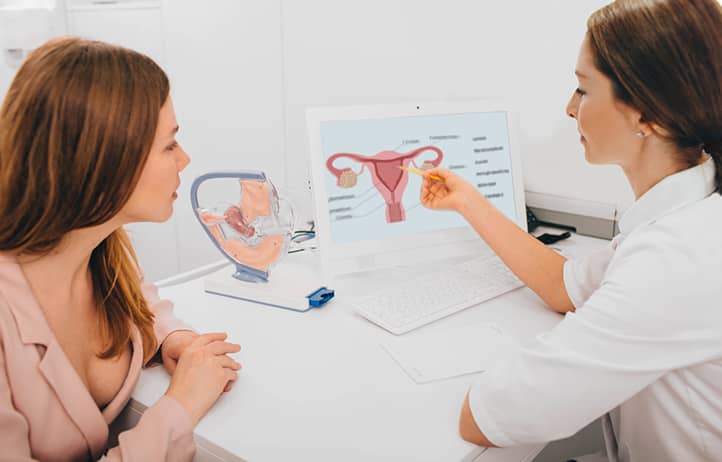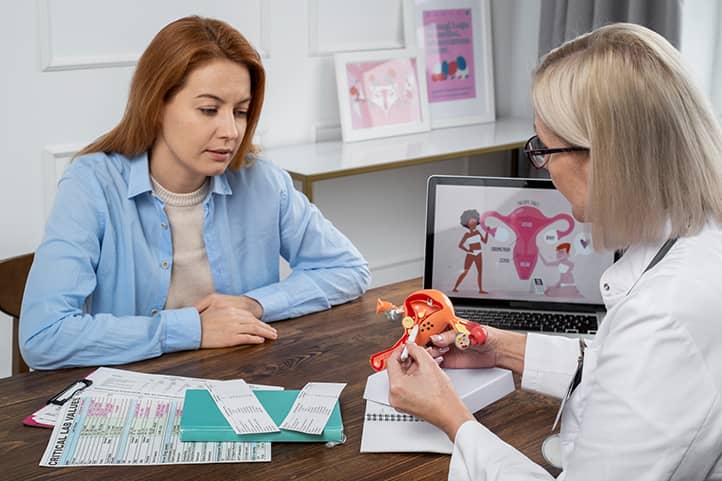In today’s world, we increasingly recognize the inseparable connection between our psyche and body. This unity is particularly evident in cases where psychological factors affect physical health and vice versa. One vivid example of this interconnection is vaginismus—a condition that requires not only medical but also profound psychological understanding.
Vaginismus is a complex issue that can significantly impact a woman’s quality of life, relationships, and self-esteem. Despite its prevalence, this topic often remains taboo, complicating diagnosis and treatment.

What is Vaginismus?
Vaginismus is the involuntary contraction of the pelvic floor muscles that occurs when vaginal penetration is attempted. This can involve sexual intercourse, the use of tampons, or undergoing a gynecological exam. It’s important to understand that vaginismus is not just a physical condition but a complex issue that includes both physiological and psychological aspects.
From a physiological perspective, vaginismus is characterized by spasms in the pelvic floor muscles, particularly in the muscle surrounding the vaginal opening (pubococcygeus muscle). This spasm can be so intense that it makes any penetration impossible or extremely painful.
From a psychological perspective, vaginismus is often accompanied by a strong fear of penetration, which can develop into a phobia. This fear can be so intense that even the thought of possible penetration causes anxiety and panic attacks.
Prevalence of the Condition
The exact prevalence of vaginismus is hard to determine due to underdiagnosis and the taboo surrounding the topic. However, according to various estimates, between 5% and 17% of women experience this issue at some point in their lives. These figures may be underestimated, as many women do not seek help due to shame or fear.
It’s worth noting that vaginismus can occur in women of any age and at any stage of life. It can affect young women just beginning their sexual lives as well as women during menopause or even after.
Research shows that vaginismus is more common in women with certain cultural or religious beliefs that may create a negative attitude toward sex. It is also more prevalent among women who have experienced sexual abuse or traumatic medical experiences.

Causes of Vaginismus
Vaginismus can arise from various causes, often related to both psychological and physical factors. Understanding these causes is key to effective treatment and prevention.
Psychological Factors
- Traumatic Experience:
- Sexual abuse or harassment can lead to vaginismus as a protective mechanism.
- A painful first sexual experience can create a negative association with sex.
- A traumatic medical experience, such as a painful gynecological exam, can trigger vaginismus.
- Fear of Pain or Pregnancy:
- Fear of pain during intercourse can lead to muscle tension and, as a result, vaginismus.
- Strong fear of unwanted pregnancy can subconsciously “close” the vaginal entrance.
- Religious or Cultural Beliefs:
- Strict upbringing that presents sex as “dirty” or “sinful” can lead to vaginismus.
- Cultural taboos around sex and female sexuality can create psychological barriers.
- The belief that sex must be painful, especially the first time, can lead to expectations of pain and, consequently, vaginismus.
- Low Self-Esteem or Body Image Issues:
- Negative attitudes toward one’s body can cause discomfort in intimate situations.
- Feeling “inadequate” or “abnormal” about one’s genitals can lead to anxiety and vaginismus.
- Stress and Anxiety:
- High overall stress levels or anxiety may manifest as vaginismus.
- Perfectionism and excessive control can lead to tension in the pelvic floor muscles.
- Negative Experiences in Relationships:
- Emotional or physical abuse in relationships can lead to vaginismus.
- Lack of emotional closeness with a partner can create psychological barriers.
Physiological Factors
- Hormonal Changes:
- Hormonal shifts, such as during menopause, can lead to vaginal dryness and discomfort, triggering vaginismus.
- Hormonal contraceptives can sometimes affect libido and natural lubrication, leading to discomfort and, consequently, vaginismus.
- Infections or Illnesses:
- Vaginal infections, such as yeast infections or bacterial vaginosis, can cause discomfort and pain, potentially leading to vaginismus.
- Endometriosis or other gynecological issues may cause pain during penetration, leading to vaginismus.
- Urinary tract infections, such as cystitis, can cause pelvic pain and lead to vaginismus.
- Anatomical Features:
- In some cases, anatomical features of the reproductive organs, such as a particularly thick hymen, can contribute to the development of vaginismus.
- Congenital anomalies in the reproductive organs can make penetration difficult and lead to vaginismus.
- Neurological Issues:
- Some neurological conditions can affect the pelvic floor muscles and lead to vaginismus.
- Spinal cord or pelvic injuries can alter the sensitivity and function of the pelvic floor muscles.
- Postpartum Changes:
- Birth trauma can lead to pain during intercourse, resulting in vaginismus.
- Physical changes after pregnancy and childbirth can cause discomfort and insecurity.
- Chronic Pain:
- Chronic pelvic pain syndrome can cause constant tension in the pelvic floor muscles.
- Fibromyalgia and other chronic pain conditions can contribute to the development of vaginismus.
It’s important to understand that vaginismus often arises from a combination of factors. For example, an initial physical issue, such as a vaginal infection, may lead to pain during intercourse. This experience can create a negative association with sex, resulting in anxiety and muscle tension during subsequent attempts at intimacy, even after the initial infection is treated.
Understanding the complexity and multifactorial nature of the causes of vaginismus is key to effective treatment. This is why a comprehensive approach, considering both physical and psychological aspects, is the most effective way to overcome this issue.

Consequences of Vaginismus
Vaginismus can have serious consequences for various aspects of a woman’s life. These consequences often extend far beyond physical discomfort and can significantly impact emotional well-being, relationships, and overall quality of life.
Impact on Sexual Life
- Inability to Engage in Intercourse:
- In severe cases, vaginismus may completely prevent penetrative sex.
- This can lead to feelings of “inadequacy” or “incapacity” in sexual relationships.
- Women may avoid any sexual contact due to fear of pain or failure.
- Decreased Sexual Desire:
- Fear of pain may lead to a decrease in libido.
- Negative associations with sex can reduce interest in sexual activity altogether.
- Women may lose the ability to enjoy sex due to constant tension and anxiety.
- Sexual Frustration:
- The inability to have a fulfilling sex life can cause frustration for both the woman and her partner.
- This can lead to tension in the relationship and feelings of guilt.
- Intimacy Issues:
- Vaginismus can lead to avoiding not only sex but other forms of physical closeness.
- Fear of intimacy may extend to other aspects of the relationship.
- Difficulty with Conception:
- For couples planning a pregnancy, vaginismus can be a significant obstacle.
- This may lead to additional stress and tension in the relationship.
Emotional and Psychological Consequences
- Decreased Self-Esteem:
- Women with vaginismus often feel “incomplete” or “broken.”
- There may be a feeling that they are “letting down” their partner.
- Low self-esteem can spread to other areas of life, affecting work, social relationships, etc.
- Depression and Anxiety:
- The constant stress from vaginismus can lead to the development of depressive and anxiety disorders.
- Feelings of hopelessness about resolving the issue can deepen depression.
- Anxiety may spread to other areas of life, leading to an overall decline in quality of life.
- Feelings of Guilt:
- Women may feel guilty toward their partner for being unable to have a “normal” sex life.
- There may be a feeling of “deceiving” the partner if vaginismus wasn’t discussed before marriage.
- Fear of Intimacy:
- Vaginismus can lead to a general fear of any form of physical closeness.
- Women may avoid new relationships due to fear of facing the issue of vaginismus.
- Loss of Sense of Femininity:
- Some women may feel that vaginismus “robs” them of part of their female identity.
- This can lead to issues with body image and sexuality.
- Social Isolation:
- Women with vaginismus may avoid social situations, especially those where discussions about relationships or sex might arise.
- This can lead to feelings of loneliness and isolation.
Impact on Relationships
- Tension in Relationships:
- Vaginismus can create tension between partners, especially if the issue is not openly discussed.
- The partner may feel rejected or think that the problem lies with them.
- Conflicts may arise due to differing expectations regarding sex life.
- Fear of Closeness:
- The woman may avoid intimacy, fearing it will lead to attempts at intercourse.
- This can lead to emotional distance between partners.
- Family Planning Challenges:
- Vaginismus can complicate or make natural conception impossible.
- This can add additional stress for couples planning to have children.
- Communication Barriers:
- Vaginismus can become a “taboo” topic in the relationship, leading to communication issues.
- Partners may struggle to openly discuss their feelings and needs.
- Risk of infidelity or relationship breakdown:
- In some cases, vaginismus can lead to a search for sexual satisfaction outside of the relationship.
- If the problem is not resolved, it may lead to a breakdown in the relationship.
- Impact on overall relationship quality:
- Problems in the sexual sphere can negatively affect other aspects of the relationship, such as trust, intimacy, and mutual support.
Impact on Overall Health and Quality of Life
- Gynecological Issues:
- Women with vaginismus may avoid regular gynecological exams, leading to missed diagnoses of other health issues.
- The inability to use tampons can cause discomfort during menstruation.
- Psychosomatic Disorders:
- Chronic stress associated with vaginismus can lead to various psychosomatic disorders, such as headaches, sleep disturbances, and digestive issues.
- Impact on Professional Life:
- The emotional stress related to vaginismus may negatively affect productivity and job satisfaction.
- Women might avoid career opportunities due to fear of new relationships or social situations.
- Overall Decrease in Quality of Life:
- Vaginismus can lead to constant feelings of anxiety and stress, affecting overall happiness and life satisfaction.
It is essential to understand that the consequences of vaginismus vary among women. Some may experience a significant impact on all aspects of life, while others may find ways to adapt and maintain quality of life despite the condition. Timely help and support from loved ones are key factors.

Symptoms of Vaginismus
Understanding the symptoms of vaginismus is key for timely diagnosis and treatment. Symptoms can vary in intensity and frequency, but they are generally divided into physical and psychological categories.
Physical Symptoms
- Pain during attempted penetration:
- This is the main symptom of vaginismus.
- The pain can range from mild discomfort to intense pain.
- Pain may occur not only during intercourse but also with tampon use or gynecological exams.
- Involuntary muscle contraction:
- During penetration attempts, pelvic floor muscles contract involuntarily.
- This contraction can be so strong that penetration becomes impossible.
- A woman may feel she cannot control these muscles, which often leads to frustration.
- Feeling of a “wall” or “obstruction”:
- Women often describe a sensation of the vaginal opening being “closed” or “blocked.”
- This may be accompanied by feelings of pressure or tension in the pelvic area.
- Discomfort during gynecological exams:
- Gynecological exams can be painful or even impossible.
- Even light touches around the vulva can cause pain or discomfort.
- Pelvic floor muscle tension:
- Even without penetration attempts, a woman may feel constant tension in the pelvic area.
- This can cause discomfort when sitting or walking.
- Lower abdominal pain:
- Some women experience chronic pain or discomfort in the lower abdomen.
- This may be related to the persistent tension in the pelvic floor muscles.
Psychological Symptoms
- Fear of penetration:
- Even the thought of vaginal penetration can cause intense fear or panic.
- This fear may also extend to medical procedures like gynecological exams.
- Avoidance of sexual activity:
- Women with vaginismus often avoid any sexual activity, even if it doesn’t involve penetration.
- This can lead to reduced intimacy in relationships.
- Anxiety before sexual contact:
- Thoughts about sex can cause intense anxiety.
- This anxiety can manifest physically: rapid heartbeat, sweating, trembling.
- Negative feelings toward one’s body:
- Women may feel disgust or hostility toward their genitals.
- This may lead to a general sense of disconnection from their body.
- Feeling of loss of control:
- Many women feel that their body “betrays” them by reacting with pain to what should bring pleasure.
- This can lead to an overall sense of lost control over their life.
- Feelings of guilt or shame:
- Women may feel ashamed of their “inability” to have “normal” sex.
- There may also be feelings of guilt toward their partner.
- Lowered self-esteem:
- Vaginismus can lead to feelings of “incompleteness” or “defectiveness.”
- This can impact overall self-esteem and confidence.
- Fear of intimacy:
- A general fear of intimacy may develop, not only physical but also emotional.
- This can affect the ability to form and maintain close relationships.
- Obsessive thoughts:
- Some women may constantly think about their condition, leading to obsessive thoughts about sex or vaginismus.
- Depressive symptoms:
- Chronic stress and frustration can lead to depressive symptoms.
- This may include loss of interest in usual activities, changes in appetite, and sleep disturbances.
It’s important to note that not all women with vaginismus will experience all these symptoms, and their intensity may vary. Additionally, symptoms may change over time or depending on the situation. For example, a woman may experience fewer symptoms with a trusted partner but feel intense anxiety at the thought of a new sexual experience.

Types of Vaginismus by Stages
Vaginismus can manifest in various ways, and it can be classified based on different criteria. One of the most common classifications is based on the time of onset and the situations in which it appears. Understanding different types of vaginismus helps doctors and psychologists develop the most effective treatment plan.
Primary Vaginismus
- Definition:
- Primary vaginismus occurs when a woman has never been able to experience vaginal penetration without pain.
- This type of vaginismus is present from the start of a woman’s sexual life.
- Characteristics:
- It is usually diagnosed in young women or those who have not yet had sexual experience.
- It may be associated with the first sexual experience or even with early attempts to use tampons.
- Often accompanied by intense fear of penetration, which may stem from unrealistic expectations or negative beliefs about sex.
- Treatment Features:
- Requires a comprehensive approach, including psychotherapy and gradual self-familiarization.
- Sexual education and myth-busting about sex play an important role.
- May include working with a partner, if there is one, to create a safe and comfortable environment.
- Prognosis:
- With proper treatment, the prognosis is generally positive.
- It is important to start treatment as early as possible to prevent the formation of negative associations and fears.
Secondary Vaginismus
- Definition:
- Secondary vaginismus develops after a period of normal sexual functioning.
- A woman previously experienced pain-free sex but developed vaginismus symptoms over time.
- Characteristics:
- It can occur at any age and at any stage of life.
- Often linked to traumatic experiences or medical issues.
- A woman may feel frustrated by the “loss” of her ability to have vaginal sex.
- Treatment Features:
- It’s important to identify and work with the cause that triggered the development of vaginismus.
- Treatment may involve both psychological work and addressing physical issues, if any.
- Often requires working on rebuilding trust in one’s body.
- Prognosis:
- The prognosis is generally positive, especially if the cause can be identified and resolved.
- Partner and family support play an important role.
Situational Vaginismus
- Definition:
- Situational vaginismus appears only in certain situations or with specific partners.
- In other situations, a woman may be able to have pain-free sex.
- Characteristics:
- May be associated with specific triggers, such as a certain position, setting, or partner.
- A woman may have normal sexual relationships in some situations but experience pain in others.
- Often linked to psychological factors like stress, anxiety, or negative associations.
- Treatment Features:
- Identifying specific triggers and working to overcome them is essential.
- May involve cognitive-behavioral therapy to change negative associations.
- Relaxation and mindfulness techniques are often effective.
- Prognosis:
- The prognosis is generally good, especially if triggers can be identified and worked through.
- Developing skills to manage stress and anxiety is important.
Global Vaginismus
- Definition:
- Global vaginismus is characterized by the constant inability to experience vaginal penetration in any situation.
- This is the most severe form of vaginismus.
- Characteristics:
- It occurs not only during sex but also with tampon use or during gynecological exams.
- It can significantly affect quality of life and a woman’s self-esteem.
- Often accompanied by intense fear and anxiety related to any type of penetration.
- Treatment Features:
- Requires comprehensive and long-term treatment, including psychotherapy, physiotherapy, and sometimes medication.
- Gradual desensitization and work on reducing overall anxiety are important.
- May involve work with a partner and family therapy.
- Prognosis:
- Treatment may be lengthy, but with the right approach, the prognosis is positive.
- Support from loved ones and professional help are crucial.
Spasmodic Vaginismus
- Definition:
- Characterized by sharp, involuntary spasms of the pelvic floor muscles.
- These spasms may occur during penetration attempts or at other times.
- Characteristics:
- Spasms can be painful and may last from a few seconds to several minutes.
- May be linked to physical factors such as neurological issues.
- Treatment Features:
- Often includes physiotherapy and exercises to strengthen and relax the pelvic floor muscles.
- Medication may be required to alleviate spasms.
- Prognosis:
- With proper treatment, the prognosis is generally positive.
- It is important to identify and address any physical causes, if present.
Understanding different types of vaginismus is essential for accurate diagnosis and selecting an effective treatment approach. It’s important to remember that every case is unique, and treatment should be individualized. Additionally, a woman may experience symptoms that correspond to various types of vaginismus, or her condition may change over time.

Diagnosis of Vaginismus
Diagnosing vaginismus requires a comprehensive approach that includes both medical examination and psychological assessment. Proper diagnosis is crucial for developing an effective treatment plan.
Medical Examination
- Medical History:
- The doctor gathers detailed information about symptoms, their duration, sexual history, and any traumatic events.
- Information about overall health, including chronic conditions and medications, is collected.
- Previous treatment attempts, if any, are discussed.
- Physical Examination:
- External examination of the genital area to rule out visible issues like infections or anatomical anomalies.
- Attempted insertion of a single finger to assess muscle reaction, muscle tension, and pain presence.
- Use of a vaginal speculum (if possible) to assess the condition of the vagina and cervix.
- Additional Tests:
- Tests for infections, including STIs and vaginal infections.
- Hormonal testing to rule out endocrine issues.
- Pelvic ultrasound (if needed) to exclude structural anomalies.
- Pain Assessment:
- Pain intensity is measured using a pain scale.
- Specific pain points and its nature (sharp, dull, burning, etc.) are identified.
- Pelvic Floor Muscle Tone Assessment:
- Specialized equipment may be used to measure the strength of pelvic floor muscle contractions.
- Assessment of the patient’s ability to consciously relax these muscles.
Psychological Evaluation
- Interview with a Psychologist or Sex Therapist:
- Discussion of emotional state, stress, and attitudes toward sexuality.
- Assessment of past traumatic experiences.
- Exploration of cultural and religious beliefs that may impact sexuality.
- Anxiety and Depression Assessment:
- Use of standardized psychological tests, such as the Beck Anxiety Inventory or the Hamilton Depression Scale.
- Evaluation of general stress levels and coping strategies.
- Relationship Analysis:
- Evaluation of relationship quality with a partner and general attitude toward intimacy.
- Analysis of communication within the couple, especially regarding sexual matters.
- Sexual Function Assessment:
- Use of specialized questionnaires to assess sexual function and satisfaction.
- Exploration of sexual history, including the first sexual experience and any past issues.
- Body Image and Self-Esteem Assessment:
- Examination of the woman’s attitudes toward her body and sexuality.
- Evaluation of general self-esteem and self-confidence levels.
Importance of a Comprehensive Approach
- Ruling Out Other Problems:
- It’s important to rule out other medical conditions that may cause similar symptoms, such as endometriosis, vulvodynia, or infections.
- A comprehensive diagnosis helps avoid misdiagnosis and ineffective treatment.
- Identifying the Root Cause:
- A thorough diagnosis helps determine if vaginismus is a primary issue or a symptom of other conditions.
- This is crucial for selecting the most effective treatment method.
- Personalized Approach:
- Every case of vaginismus is unique, and a comprehensive diagnosis allows for the development of an individualized treatment plan.
- Both physical and psychological factors affecting the patient’s condition are taken into account.
- Assessment of Readiness for Treatment:
- A comprehensive diagnosis helps assess the patient’s motivation and readiness for various treatment methods.
- This is important for selecting an appropriate pace and approach to therapy.
- Building Trust:
- The diagnostic process helps establish a trusting relationship between the patient and the medical team.
- This is critically important for successful treatment, given the intimate nature of the issue.
It’s important to note that diagnosing vaginismus can be a complex process, requiring sensitivity and patience from both medical professionals and the patient. Many women may feel shame or anxiety during the examination, so creating a comfortable and safe atmosphere is essential.
Furthermore, the diagnosis of vaginismus may not always be completed in a single visit. Several sessions may be required to fully understand the situation and establish an accurate diagnosis. This is especially important in cases where vaginismus is secondary to other medical or psychological issues.

How to Treat Vaginismus?
Treating vaginismus is a complex process that requires patience and cooperation between the patient, her partner, and medical professionals. It’s essential to understand that there is no universal treatment suitable for everyone. The approach must be individualized, considering both the physical and psychological aspects of the condition.
Psychotherapy
- Cognitive Behavioral Therapy (CBT):
- Helps identify and change negative thoughts and beliefs about sex and intimacy.
- Teaches relaxation techniques and anxiety management.
- Develops coping skills to overcome fear and anxiety.
- Eye Movement Desensitization and Reprocessing (EMDR):
- Particularly effective for patients with a traumatic history.
- Helps process traumatic memories and reduce their emotional impact.
- Sex Therapy:
- Focuses on improving communication between partners about sexual matters.
- Helps foster a positive attitude toward sexuality and the body.
- Provides practical advice on intimacy and sexual activity.
- Desensitization:
- Gradual acclimation to thoughts of penetration and physical contact.
- May include mindfulness exercises and meditation.
- Often used in combination with physical therapy methods.
Physical Therapy
- Kegel Exercises:
- Strengthen pelvic floor muscles and improve control over them.
- It’s essential to learn not only to tense but also to relax these muscles.
- Biofeedback:
- Use of specialized equipment to visualize pelvic floor muscle tension.
- Helps patients learn to consciously control these muscles.
- Use of Vaginal Dilators:
- Gradual increase in dilator size to become accustomed to the sensation of penetration.
- Used under the supervision of a physiotherapist or independently at home.
- Manual Therapy:
- Massage and stretching of pelvic floor muscles to reduce tension.
- May include both internal and external massage.
Medication Treatment
- Topical Anesthetics:
- May be used to reduce sensitivity of the vulva and vaginal entrance.
- Typically used temporarily during the initial stages of treatment.
- Antidepressants:
- May be prescribed for coexisting depression or anxiety disorders.
- Some antidepressants can also help reduce chronic pain.
- Botulinum Toxin:
- In some cases, may be used to relax overly tense pelvic floor muscles.
- Used with caution and is not a first-choice treatment.
The Importance of a Comprehensive Treatment Approach
- Personalized Treatment Plan:
- Developed considering the specific symptoms and causes of vaginismus in each patient.
- May include a combination of various treatment methods.
- Multidisciplinary Approach:
- Involvement of various specialists: gynecologist, psychologist, physiotherapist, sex therapist.
- Ensures comprehensive support and treatment.
- Involvement of a Partner:
- It’s important to include the partner in the treatment process, if possible.
- Improves understanding and support within the relationship.
- Gradual Progress and Patience:
- Treating vaginismus is a process that may take time.
- It’s essential not to rush and avoid creating additional pressure on the patient.
- Regular Monitoring and Adjustment of the Treatment Plan:
- Progress assessment and adjustment of the approach as needed.
- Ensures the most effective treatment.

How to Prevent the Onset of Vaginismus?
While it may not always be possible to fully prevent vaginismus, certain steps can reduce the risk of its development or help identify the problem early.
- Education and Awareness:
- Comprehensive sexual education from an early age.
- Debunking myths and misconceptions about sex and the female body.
- Encouraging open discussions of sexual topics in society.
- Focus on Mental Health:
- Developing a healthy attitude toward one’s body and sexuality.
- Working to overcome anxiety and fears related to intimacy.
- Seeking psychological support if there is a history of trauma.
- Regular Medical Check-Ups:
- Annual visits to a gynecologist for early detection of issues.
- Timely treatment of infections and other gynecological problems.
- Discussing any changes in sexual health with a doctor.
- Open Communication with a Partner:
- Developing communication skills on sexual topics.
- Discussing fears, desires, and expectations with a partner.
- Creating an atmosphere of trust and safety in relationships.
- Mindfulness and Relaxation Practices:
- Learning relaxation techniques to reduce overall stress.
- Practicing mindfulness to better understand one’s body and its responses.
- Healthy Lifestyle:
- Regular physical exercise to improve overall well-being and reduce stress.
- Balanced nutrition to maintain hormonal balance.
- Adequate sleep and rest.
- Seeking Help Early:
- At the first signs of discomfort or pain during sex, it’s important to see a doctor.
- Do not ignore sexual health issues, hoping they will “go away on their own.”

Conclusion
In conclusion, vaginismus is a complex condition that affects both the physical and psychological aspects of a woman’s life. It is not merely a physiological problem; vaginismus often reflects deeper emotional or mental difficulties, making its resolution multifaceted and requiring a comprehensive approach. Recognizing that the body and mind are closely linked allows for a deeper understanding of the roots of this condition.
One of the key aspects of treatment is psychotherapy. It helps identify emotional blocks, fears, or traumatic experiences that may trigger vaginismus. Working with a psychologist or sex therapist enables women to overcome these psychological barriers, reducing anxiety and strengthening confidence in their bodies.
Additionally, physiotherapy and relaxation techniques play a significant role in treating vaginismus. Exercises to strengthen and relax the pelvic floor muscles help women gradually regain control over their bodies, while becoming more familiar with their anatomy helps to overcome the fear of penetration.
Involving a partner in the treatment process is also essential. Open discussions of the issue with a partner and their support create an atmosphere of trust, helping the woman feel more comfortable and confident.
Finally, it’s important to emphasize that each case of vaginismus is unique and requires an individualized approach. A comprehensive therapy plan that considers both physical and psychological aspects is the most effective. Through patience, collaboration with professionals, and personal commitment to change, women can succeed in overcoming this condition and restoring a fulfilling intimate life.




